Coming Home: 2019 Balsamiq Nest Retreat

If you receive our company newsletter, you'll know in addition to working heads down on the upcoming release of native Mac and Windows desktop clients, during the last year we've also been building a new office in Bologna, Italy, which we call "The Nest." Having this beautifully designed place (we'll share more about it and the design process in the future) scheduled to finish construction around the time of our annual retreat, made it an obvious choice for a location this year.
But the journey to this retreat made the location a particularly meaningful choice. We made a physical journey to gather at this new hub, a space Peldi in his design hoped would be a home place for anyone who works at Balsamiq; a place we felt we belonged no matter where we live. That physical journey to The Nest echoed for me the journey we've been on together over the past year uniting as a company to face some very difficult challenges.
Defining the problem
Last year, rather than a regular company retreat, we had a special family and friends week-long celebration for the 10th anniversary of our little company. While we did have a great week, in the background of this celebration we were all aware that we had some big challenges ahead. A few days before the anniversary party, Peldi shared very honest words about our challenges as a company, and also vulnerably let us know some of his personal struggles.

Some of what Peldi shared many of us were aware of, other things came as a surprise. But in both cases, his transparency opened the channel to begin working on these issues as a team.
The issues didn't relate to financial trouble, or a toxic work culture. We were and are doing fine financially, and I have always noted how lucky I am that I like all the humans I work with. But we had developed some dysfunctions as a company.
How we manage work, how we are structured, how we communicate: all of these things were slowly getting out of alignment. Sort of like an unbalanced washing machine, we were beginning to rock more and more.
At the core of our problems: too much of Balsamiq revolved around Peldi. It was too much for any one human to do well, and Peldi also recognized there were some areas he didn't have the right skills or interest in doing.
I suppose conventional business advice would be for Peldi not to share his uncertainties and his deep personal concerns with the entire company. We might freak out and sense chaos. But we've never really followed conventional business advice. Instead, Peldi's courageous choice to lay everything on the table, his fears and anxieties included, was what allowed us to join together to start building solutions.
We care so deeply about our jobs, our community, our company, each other, and of course our leader (and also my dear friend) Peldi, that we began the process of looking at these problems with focus and openness.
The first step in truly defining the problems was a lot of listening. We needed to listen and hear from Peldi but also from each other. You can hear more about Peldi's struggles, as well as the first steps we took in collecting information through a series of company discussions in his 2018 Business of Software talk.
Building solutions
Out of that process of discovery we identified five major tension points - and they were big concepts, not things that have easy or straightforward solutions.
We began working on these tension points in various ways, one of which was to change the model of our annual retreat. Our very earliest retreats included a good amount of work time. We were a young company and needed to really figure out who we were and how we wanted to work.
As the years went by however, we started dropping "work" sessions. We wanted to just enjoy the chance we miss all year long: seeing one another face-to-face. Retreats were about building memories, jokes, and relationships through fun activities, food, and hanging out.
But in the face of some really big company-wide issues, coming together just to be together while not addressing the giant elephant(s) in the room seemed unwise. We instead decided to return to a "working retreat" model.
While recent retreat planning focused on travel, activities, and food, we added a Program Team to design the concept and content of the retreat.
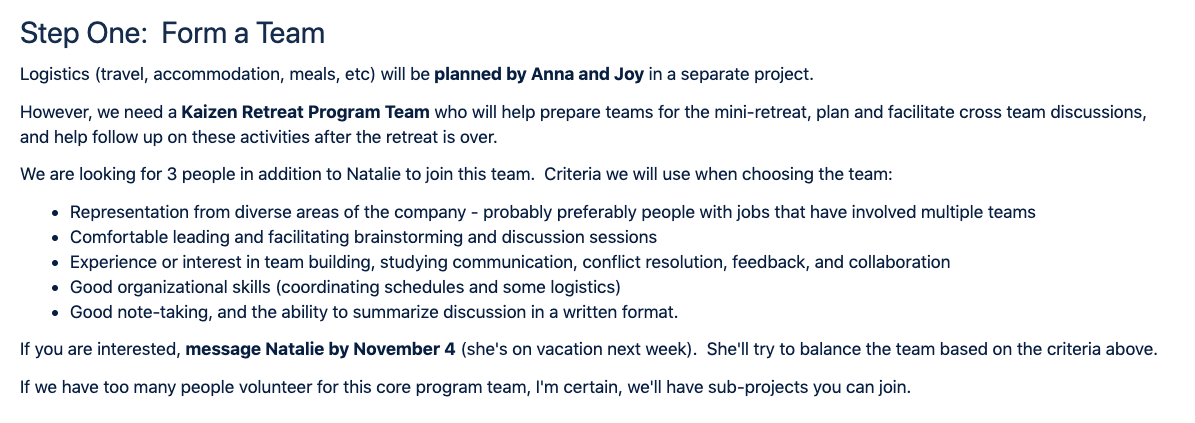
As a Program Team, we wanted to make sure we were truly listening to our co-workers. We had the notes and tension points from the summer discussions to work from, but it was also important to us that our design choices for the retreat matched what we thought our coworkers wanted.
To do this Jess, our User Research Team Lead, created a survey in December to collect input. As you might expect: humans all want very different things. 😊 But the survey provided the information we needed to start sculpting the week.
It was clear we needed to balance many things: "work" time and "social" time being the biggest things. In addition, while we originally thought the week would be more about mini retreats for individual teams, the survey showed us we needed to also have time for company and cross-team issues, and individual personal development. People absorb information differently, so we took care to balance the workshop format types: discussion groups, talks, and interactive workshops. Marco kept our team on their toes by making sure we had considered the "why" behind each of our choices.
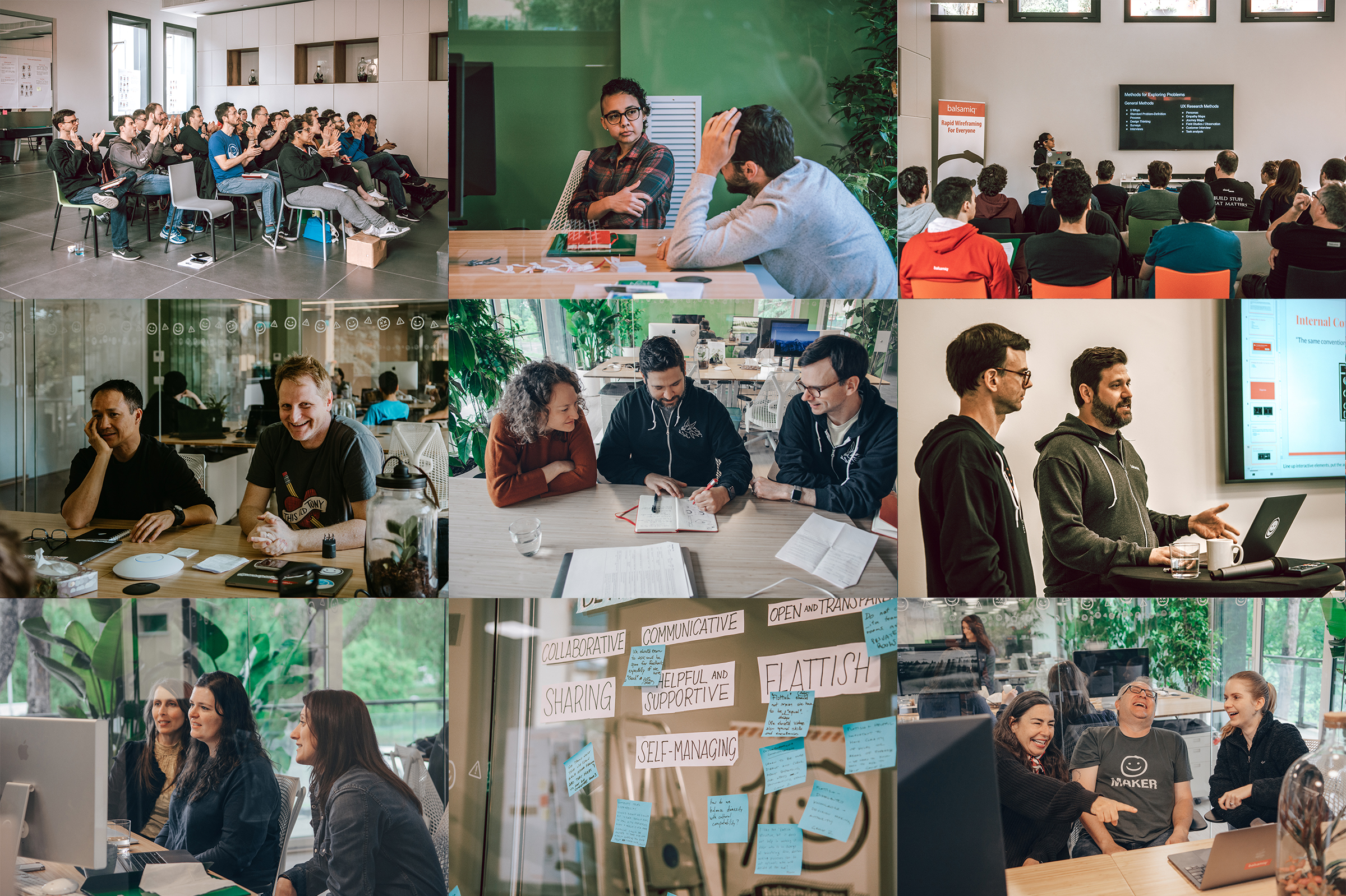
The general structure of the week was four hours of morning workshop time at The Nest, followed by an informal catered lunch.
The afternoons were open for activities (we had a few organized, but people were free to self-organize or take time to rest), followed by dinners together in Bologna's city center.
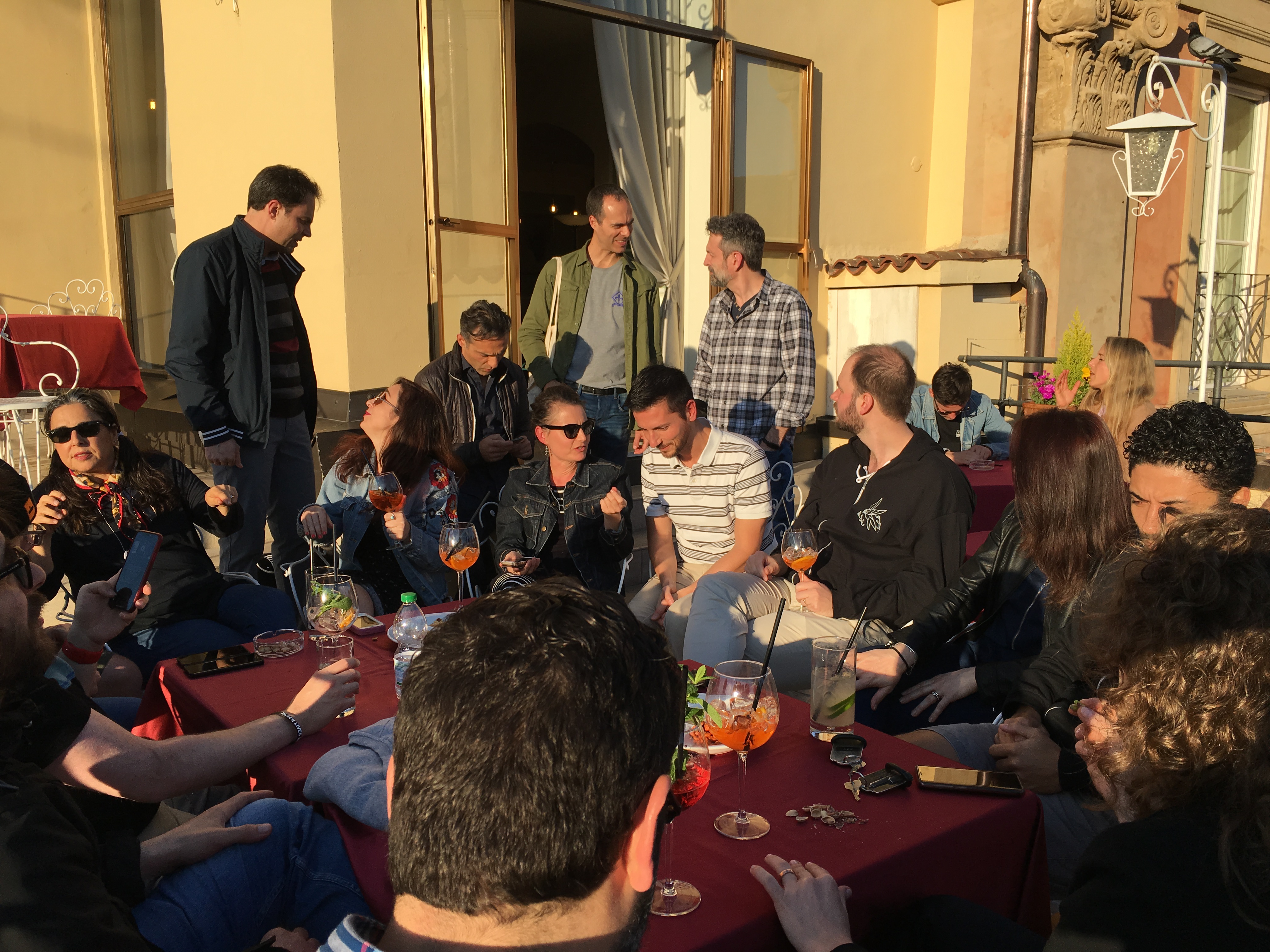
Although we have a few things we'd like to change, the work done by the Logistics and Program Teams seems to have been a success.
"I think we had a right balance between work and fun time. Before going to bed I felt tired but at the same time happy about the energy I received from every person during the day. After the retreat I kept thinking about all memories collected and all the experiences I had with everyone, I felt closer to my colleagues-friends and more motivated." - Andrea
Retreat highlights
The tension points I mentioned before don't exactly fit in neat little boxes, and our design choices for the retreat often were related to more than one of them, but here are some highlights that related to each area.
Tension Point: The big picture and vision is not clear to everyone. This makes many people hesitate to make decisions, set priorities, and in some cases, they make choices that are not the best for everyone in the company.
One of the main things about this tension point was a recognition that we had some silos and that Peldi could not be the only glue connecting us.
For the retreat we really wanted to open up new channels of communication within the company. Although we are very friendly folks, in the past few years we noticed people tend to gravitate towards colleagues they already know, and even when making a conscious effort to reach out to new people, conversations can sometimes stay a bit on the surface.
We felt with just a little bit of structure, we could create an environment for deeper conversations.
Throughout the week, we purposefully assigned people to some of the activities so we each had a chance to interact in a meaningful way with everyone in the company. When assigning groups I looked at where people live, what teams they are on, how long they had been in the company, and even tried a bit to balance the extroverts and introverts in order to try to create the most diverse mixture possible.
“I appreciated so much the opportunity of having "working" activities with people I usually do not work with; this gave me the confirmation that we all are smart and good people (I was aware of it but having a confirmation with direct/concrete facts is a totally different thing)”. - Michele
The first place we did this was for two sets of discussion groups made of 11 people each. We had one group for discussing the first iteration of our new Company Values and the second set of groups for brainstorming ideas related to different areas of project management: Diplomacy & Difficult Conversations, Self Management & Organization, and Collaboration & Decision Making.
Each group had someone assigned as the facilitator and a note taker to capture ideas shared during the discussion.
The second way was perhaps the most loved feature of the entire retreat. Rather than trying to find restaurants that could feed all 33 of us each night, which can be difficult and wouldn't be the intimate experience we were looking for, for four of the nights, we assigned "dinner groups" of 8-9 people. While we still had all company dinners on the first and last nights, we mixed the groups the other nights. Each group was assigned a "Dinner Lead" who was charged with picking the restaurant, making the reservation, and getting their dinner companions to and from the restaurant.
“The idea of breaking up into small dinner groups was fantastic. It totally brought back the feeling of the first retreats, even though now we're a big gang." - Stefano
Tension Point: Peldi doesn't have the time to do the job he needs to do for the company.
As you can imagine, there are a lot of different reasons for this tension point! But one of them relates to leadership and clarity of roles. We wanted to build leadership skills, but also empower and encourage the leadership abilities we already have in the company.
Although it probably took more effort to coordinate than if the Program and Logistics Teams had done all the work ourselves, we worked hard to tap our colleagues for help. We did our best to give them the information they needed to fulfill their role using their own abilities within the overall framework we created.
Everyone was asked to help in some way at the retreat (we each had one day of lunch KP duty!), but 28 out of 33 of us had at least one thing we were asked to personally lead. It was everything from leading 15 minutes of ice breakers, a dinner group, giving a talk, facilitating a discussion, to coordinating audio visual set-up.
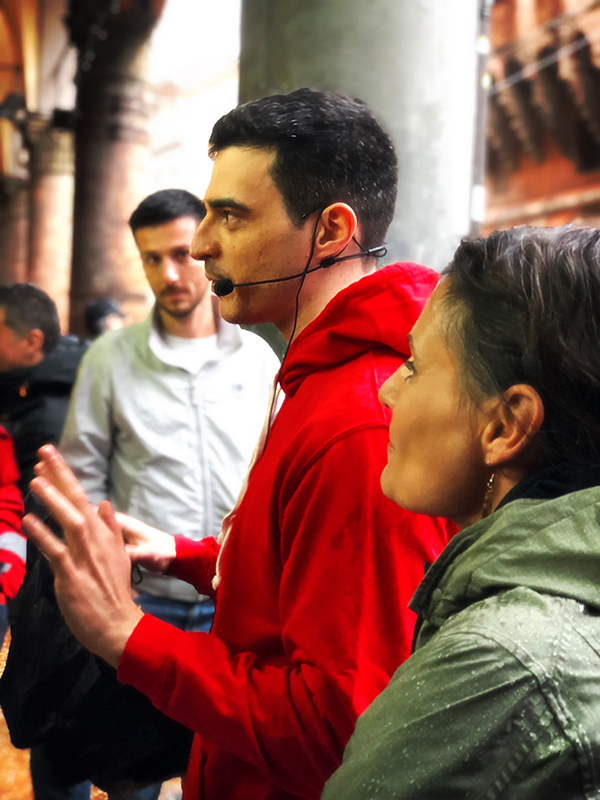
I had wiki page to track these things to make sure we had all areas covered, but half of my joy in keeping that page up-to-date was seeing the cross-company involvement.
The ownership and quality of the work everyone did made the retreat teams extremely proud, and the creativity that came out was delightful to see. None of us who joined Tommaso on his guided tour of Bologna (on a VERY rainy day) which ended at a cafe where he serenaded us on the piano, will ever forget that wonderful afternoon he created for us. And the work Laura Lei did related to graphic design (she'll be sharing about that in a blog post soon) brought a warm and whimsical atmosphere to the entire week.
Tension Point: Not all Teams feel unified or able to operate, make decisions, or prioritize as a unit.
Having lighting talks followed by discussion groups related to project management was a choice to help teams related to this tension point, but we also provided 6 hours of scheduled "Team Time." We left what the teams did with their time to the teams to decide, however Virgin worked with team leads to make sure they had an outline of how they would utilize the hours.
The most difficult part of this was related to scheduling. We have a very organic structure at Balsamiq so many (most) of us do work on multiple teams. Figuring out the time slots was tricky, and did leave some teams with a much shorter "all team" time than others.
This time allowed some teams to co-work while catching up on regular work (particularly our hardworking support and sponsorship team members), but it mainly was used by teams to step back from their daily work and look at things like communication issues and long-term planning.
“I liked spending time doing work there. It felt important and necessary because most of those conversations weren't about day-to-day stuff. We should have those big picture conversations at least once a year. And it also served to create bonds between us, just as much as the social activities.” - Leon
Tension Point: In the various product development teams, we have some things that could/should be more universally shared.
The last few years much of our product development focus has been dedicated to rewriting our code for native Mac and Windows desktop clients. With that as our main focus, we were slowly outgrowing our product design processes. While we have been recognizing this issue for a while now, it was hard to take time to improve the issue while still keeping the desired momentum for the upcoming release. The betas were underway by the time of the retreat, so it was a great opportunity to start planning the needed improvements for the future.
Peldi led two "How We Build Product" work groups during the retreat - gathering a broad group of 22 people whose work relates to all areas the product develop process: all development teams, our designer, representatives from sales and tech support, documentation, and myself as a representative for Kaizen projects.
Out of these sessions came some great brainstorming points, a few action items, as well as project teams to begin working on a few areas such as defining our entire design process and improving communication between development teams.
Tension Point: We have a big hole where Performance Reviews and many Human Resources functions should be.
Our long tradition of having a "flattish" structure and no managers, is both loved by our company, and a source of frustration. One of those frustrating elements as we've grown relates to various issues which might normally be cared for by a good manager, such as performance and skill improvement, facilitating conflict resolution, career development, and salary setting.
As a Program Team, one of the ways we adressed it was building self and team awareness. I led a workshop about different personalities and work styles. We know you can't really categorize humans, but many people enjoyed visually seeing and talking about their different approaches and ways of thinking. The overall goal was to recognize our differences in order to maximize our strengths and build understanding of our individual weaknesses.
We also had a great lightning talk on Non Violent Communication techniques by Mike, followed by a discussion group which brainstormed ideas for building a better environment for giving feedback.
We still have a long way to go in the area of professional development, and recognizing and developing the talents of our team. But these sessions, as well as some ideas that emerged during our Company Values discussions, provided us with tools for shaping these improvements.
While not particularly related to one of the tensions, I want to mention one very practical highlight of this year's retreat. In the process of trying to schedule all these diverse groups of people, and wanting to give people freedom to plan their own social activities in the afternoon, I realized communication about when and where people needed to be was going to be a big challenge. In the past we all needed to be at the same place at the same time - a simple wiki agenda for everyone to reference was all that was needed.
This year's schedule however was a complex matrix. Each person had a slightly different schedule and I could see, without a good communication mechanism, I would have spent the entire retreat directing everyone and have to be involved on troubleshooting many issues.
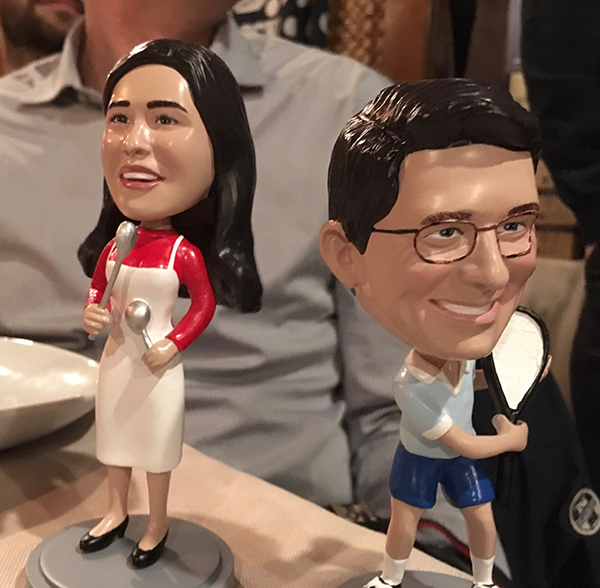
I asked Ali to help develop a script that could turn my very detailed (and difficult to parse) Google Spreadsheet into a beautiful personal agenda for each person. The agendas let every person know where to be, when, who the lead of the activity was, and who else should be there.
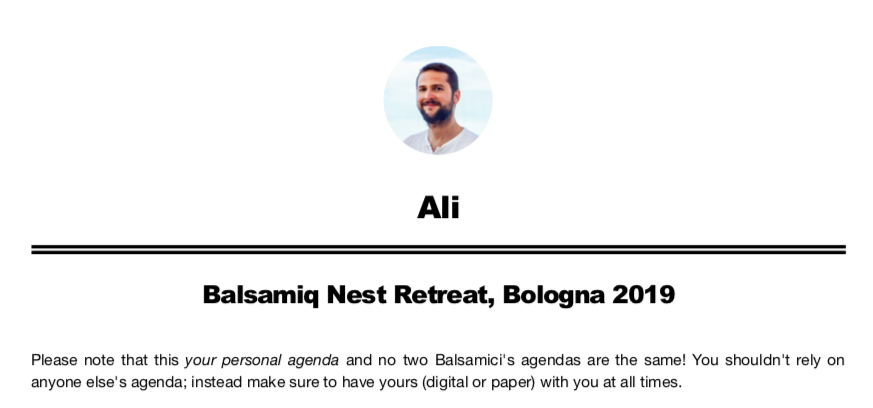
“I loved loved LOVED the daily agenda. As soon as I received mine I felt I was all set. :)” - Amanda
For me, they were an incredible relief, and allowed me to really enjoy the retreat even while I was leading it. Everyone had in their hands (or on their devices) the information they needed to get themselves were they needed to be, to know when they could go on an unplanned adventure, and who to contact in order to make changes to the original plan.
What's next?
We didn't fix all of our issues. We have some tough challenges and conversations still to come, but it was great to utilize the annual retreat as a tool for working on improvements.
The information we gathered during the retreat helped to refine the roadmap for our 2019 Kaizen Team projects. Conversations during structured and unstructured time have already resulted in better decision-making in teams, promoted sharing within the company, and inspired creative ideas.
It's just over a year since Peldi shared his thoughts with us. We've come a long way in working through these issues, and we've got a long way to go. But our company has a culture of ongoing improvement - kaizen. I feel dedication and optimism from my coworkers: with patience, our combined skills, and a commitment to collaboration - we are sure we can build an even better company together.
We'll be keeping the retreat format (the location and overall structure) we developed this year for our annual retreat in 2020.
What questions and content will we focus on? We'll wait to see where we are at as a company in six months to answer that question.
But our time together in person is too valuable not to take advantage of it to define problems and build solutions. As Sax put it, "we have a great potential of collective knowledge inside our company."
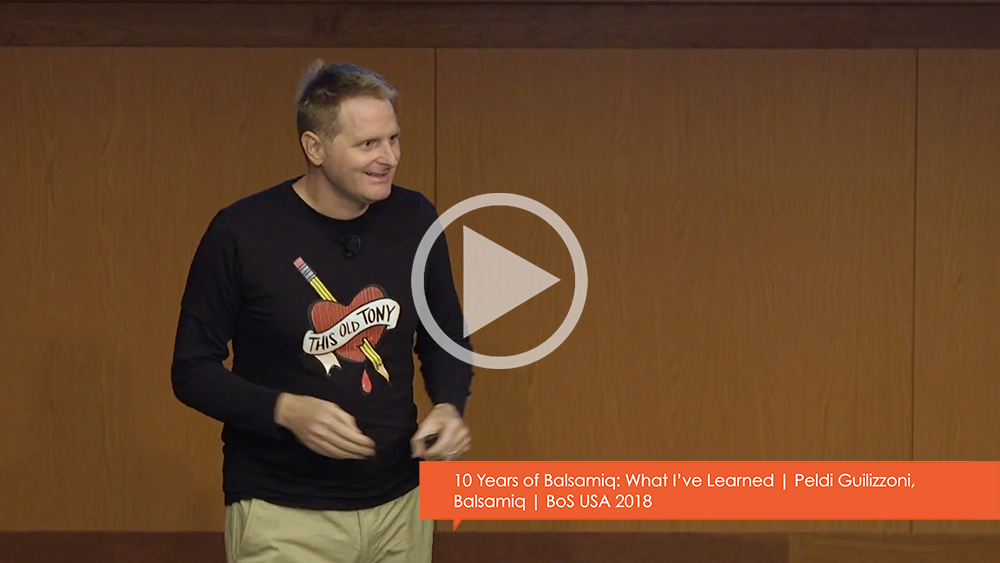



Comments (3)
I love this post and the transparency that highlights such a great company. I have been watching the growth through the years and still are amazed at the team partnership which is crucial for any company. Keep up the great work and again thanks for the eyeopener!
Wonderful, congrats!
I thought Balsamiq was a remote/distributed team? Has that changed now? or are you a blend of in-person and remote?
Hi Linda! Thanks for the congratulations. We are still a remote- first, distributed team. About 50% of us work from home full-time and we are located in 4 European countries and 2 US states. However our colleagues near Bologna do have the option to work from the Nest (as they did at our previous offices) whenever they want. So some people do see each other in person semi-regularly. However, all of our communication and work processes are designed for remote work; there are no requirements to ever be at the office (well maybe to check the mail sometimes. 🙂 ).